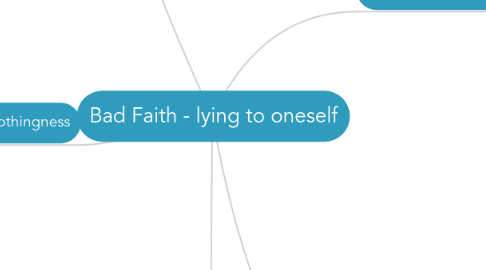Bad Faith - lying to oneself
by Anna Bromely


1. In summary
1.1. S seeks to explain failures of self-knowledge and more generally, irrationality in metaphysical terms.
1.2. -There are 2 modes of being: for-itself and in-itself -We exhibit both modes of being. -Our fundamental project stems from having to reconcile these opposing aspects of our being. It tries to rectify the deficiency that arise from consciousness experiencing an insufficiency of being as follows: The for-itself become in-itself, The for-itself negates the in-itself, the for-itself attempts to evolve a third mode of being. I.e. It attempts to become god. This project is futile because it is metaphysically impossible.
2. Bad faith and Nothingness
2.1. Bad faith is an extension of his theory of nothingness. conscious nihilates parts of world - may also turn its power of negation on itself.
2.2. Famous example is of waiter who desires to turn himself into his role. To convert his essence into an incarnation of the essence 'waiter'. Thinking about himself in thing-like terms. Relieved of the burden of freedom and responsibility. Woman who goes out with man and in moment where he takes her hand she promotes the contradictory notion of not-being (leaving her hand unclasped). This is a matter of choice at the pre-reflective level. Ceasing to identify with her body. Wants to flee from embodied predicament. All such actions are undertaken freely and thus presuppose what they seek to deny.
3. The Desire for Being
3.1. 'What must be the being of man if he is capable of bad faith' We are deeply contradictory
3.2. Consciousness is empty and driven by a lack of self-identity. 3 aspects that create this lack of identity: 1. The circuit of selfness - Reflection is key as it involves separation of self from self. Leaves subject oscillating between unity and duality. 2. Temporality - Negation is inserted into the structure of the for-itself as the for-itself has a past and is in flight towards the future. It is not identical with its past or future. 3. Facticity (accrual of objective features through its occupation) and transcendence (freedom, spontaneity, activity, possibility) - Simultaneous occupation with these 2 contrary dimensions.
3.3. The fundamental project which compromises the for-itself and in-itself is to achieve equilibrium. All of our projects derive from a desire for being. The project thus yields 3 imperatives for the for-itself: to become in-itself, to assert its own mode of being and negate itself; and to become its own foundation.
4. The problem of self-deception
4.1. S notion of bad faith and Freud's conception of the dynamic unconscious are competing accounts of what may be called failures of self-knowledge.
4.2. Fail to recognise own motivation Don't seem to know their own minds Don't seem to know the reasons for acting in the way they do
4.3. Sartre's doctrine is that self-knowledge (SK) is complete and inescapable and that failures of self-knowledge are looked at in metaphysical terms - humans misrepresent ourselves to ourselves.
4.3.1. Inspire someone about your topic?
4.3.2. Specific grade?
4.3.3. Do your best work?
5. Sartre's critique of Freud
5.1. Failures of SK imply that the mind is divided. The question of responsibility then becomes very murky.
5.2. Freuds theory:
5.2.1. Violates unity of the self
5.2.2. Abnegates human responsibility
5.2.3. Misrepresents the nature of motivation
5.2.3.1. Books
5.2.3.2. News sources
5.2.3.3. Blogs
5.2.3.4. Supporting Data
5.2.3.4.1. Expert reports
5.2.3.4.2. Third party research
5.2.3.4.3. Survey data
5.2.3.4.4. Size of topic
5.3. Psychoanalysis perceives of the mind as only partially integrated and opaque to itself in many respects. This clashes with Sartre's picture of consciousness. Bad Faith reveals the source of human motivation. The source can be traced back to our contradictory human being (for-itself and in-itself)
5.3.1. This account preserves: -Unity of the self -The self's responsibility for itself.
5.3.2. S proposes 'existential psychoanalysis'
